Environmental and Energy Law Policy: Climate Change Agreements Report
VerifiedAdded on 2022/08/12
|9
|3568
|8
Report
AI Summary
This report examines key international agreements and policies related to environmental and energy law. It begins with an overview of the United Nations Framework Convention on Climate Change (UNFCCC), discussing its development, purpose, and the factors that influenced its creation. The report then analyzes the Kyoto Protocol and the Paris Agreement, detailing their objectives, implementation, and impact on global efforts to combat climate change. Furthermore, the report explores the Renewable Energy Directive 2009/28/EC, its objectives for renewable energy consumption within the European Union, and its evolution to the recast Renewable Energy Directive 2 (RED II). The report also touches upon wind energy in Ireland as a significant source of renewable energy. The analysis covers the historical context, legal frameworks, and the impact of these policies and agreements in addressing climate change and promoting sustainable energy practices. It provides a comprehensive overview of the international efforts to mitigate the adverse effects of human activities on the environment.
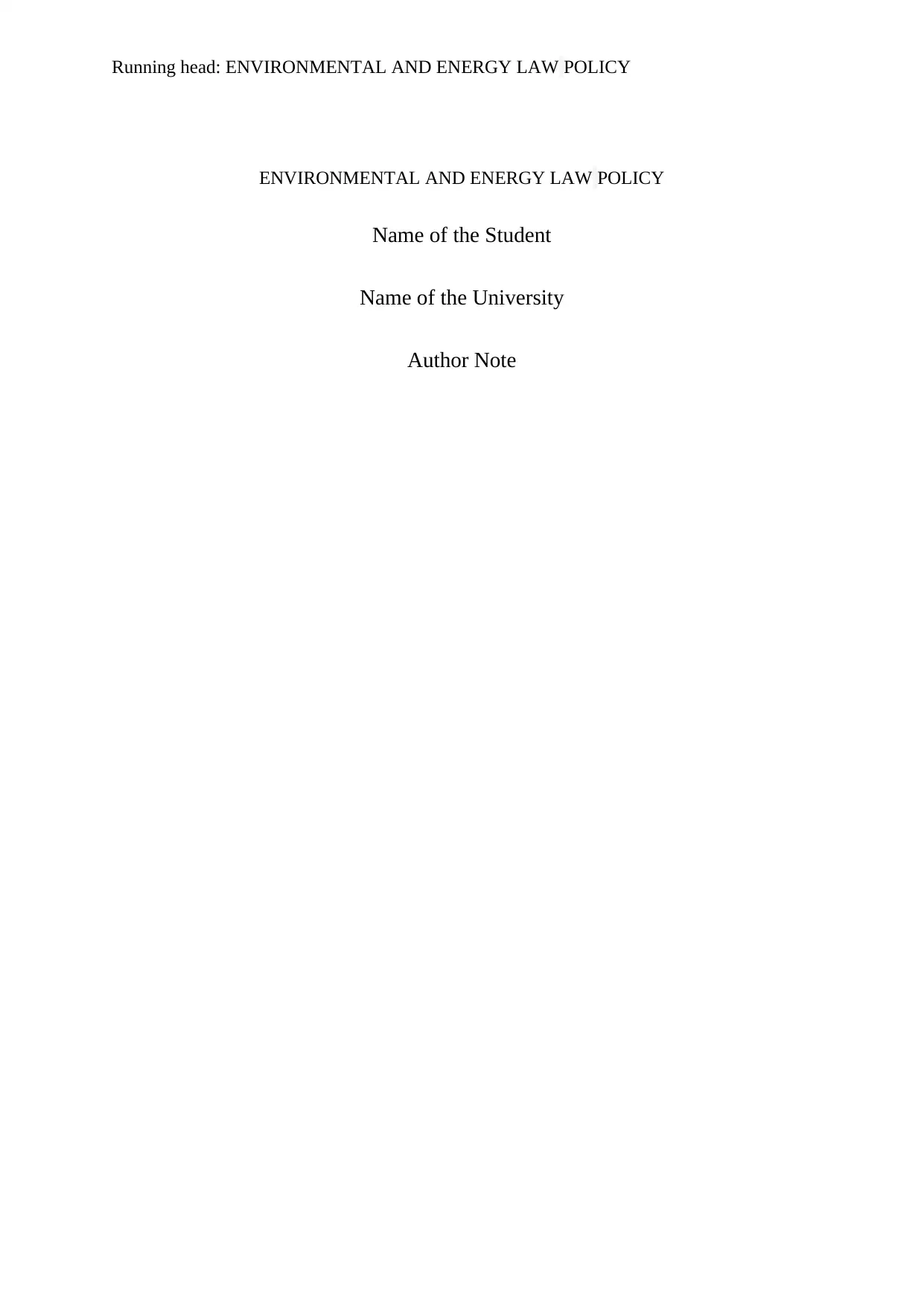
Running head: ENVIRONMENTAL AND ENERGY LAW POLICY
ENVIRONMENTAL AND ENERGY LAW POLICY
Name of the Student
Name of the University
Author Note
ENVIRONMENTAL AND ENERGY LAW POLICY
Name of the Student
Name of the University
Author Note
Paraphrase This Document
Need a fresh take? Get an instant paraphrase of this document with our AI Paraphraser
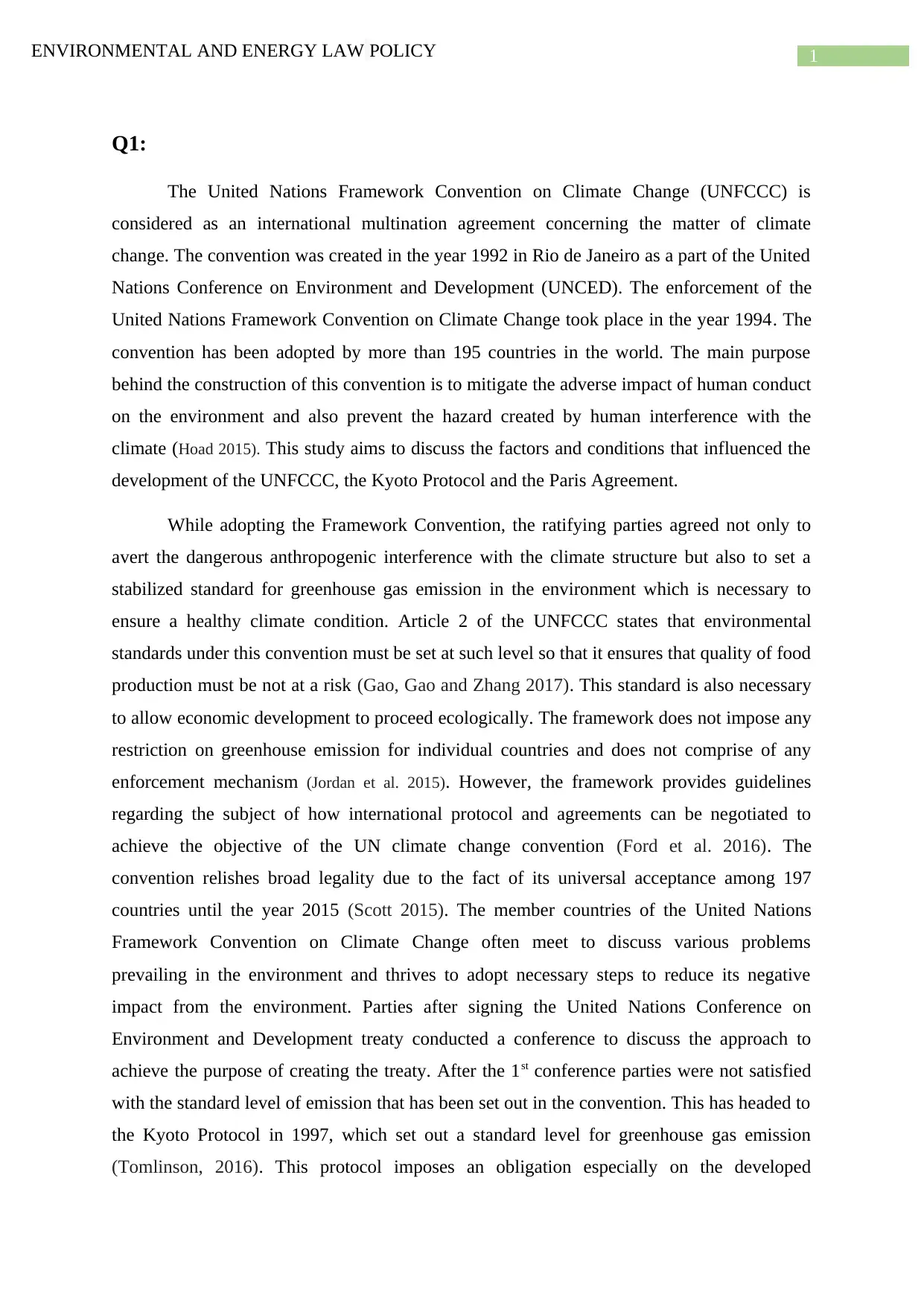
1ENVIRONMENTAL AND ENERGY LAW POLICY
Q1:
The United Nations Framework Convention on Climate Change (UNFCCC) is
considered as an international multination agreement concerning the matter of climate
change. The convention was created in the year 1992 in Rio de Janeiro as a part of the United
Nations Conference on Environment and Development (UNCED). The enforcement of the
United Nations Framework Convention on Climate Change took place in the year 1994. The
convention has been adopted by more than 195 countries in the world. The main purpose
behind the construction of this convention is to mitigate the adverse impact of human conduct
on the environment and also prevent the hazard created by human interference with the
climate (Hoad 2015). This study aims to discuss the factors and conditions that influenced the
development of the UNFCCC, the Kyoto Protocol and the Paris Agreement.
While adopting the Framework Convention, the ratifying parties agreed not only to
avert the dangerous anthropogenic interference with the climate structure but also to set a
stabilized standard for greenhouse gas emission in the environment which is necessary to
ensure a healthy climate condition. Article 2 of the UNFCCC states that environmental
standards under this convention must be set at such level so that it ensures that quality of food
production must be not at a risk (Gao, Gao and Zhang 2017). This standard is also necessary
to allow economic development to proceed ecologically. The framework does not impose any
restriction on greenhouse emission for individual countries and does not comprise of any
enforcement mechanism (Jordan et al. 2015). However, the framework provides guidelines
regarding the subject of how international protocol and agreements can be negotiated to
achieve the objective of the UN climate change convention (Ford et al. 2016). The
convention relishes broad legality due to the fact of its universal acceptance among 197
countries until the year 2015 (Scott 2015). The member countries of the United Nations
Framework Convention on Climate Change often meet to discuss various problems
prevailing in the environment and thrives to adopt necessary steps to reduce its negative
impact from the environment. Parties after signing the United Nations Conference on
Environment and Development treaty conducted a conference to discuss the approach to
achieve the purpose of creating the treaty. After the 1st conference parties were not satisfied
with the standard level of emission that has been set out in the convention. This has headed to
the Kyoto Protocol in 1997, which set out a standard level for greenhouse gas emission
(Tomlinson, 2016). This protocol imposes an obligation especially on the developed
Q1:
The United Nations Framework Convention on Climate Change (UNFCCC) is
considered as an international multination agreement concerning the matter of climate
change. The convention was created in the year 1992 in Rio de Janeiro as a part of the United
Nations Conference on Environment and Development (UNCED). The enforcement of the
United Nations Framework Convention on Climate Change took place in the year 1994. The
convention has been adopted by more than 195 countries in the world. The main purpose
behind the construction of this convention is to mitigate the adverse impact of human conduct
on the environment and also prevent the hazard created by human interference with the
climate (Hoad 2015). This study aims to discuss the factors and conditions that influenced the
development of the UNFCCC, the Kyoto Protocol and the Paris Agreement.
While adopting the Framework Convention, the ratifying parties agreed not only to
avert the dangerous anthropogenic interference with the climate structure but also to set a
stabilized standard for greenhouse gas emission in the environment which is necessary to
ensure a healthy climate condition. Article 2 of the UNFCCC states that environmental
standards under this convention must be set at such level so that it ensures that quality of food
production must be not at a risk (Gao, Gao and Zhang 2017). This standard is also necessary
to allow economic development to proceed ecologically. The framework does not impose any
restriction on greenhouse emission for individual countries and does not comprise of any
enforcement mechanism (Jordan et al. 2015). However, the framework provides guidelines
regarding the subject of how international protocol and agreements can be negotiated to
achieve the objective of the UN climate change convention (Ford et al. 2016). The
convention relishes broad legality due to the fact of its universal acceptance among 197
countries until the year 2015 (Scott 2015). The member countries of the United Nations
Framework Convention on Climate Change often meet to discuss various problems
prevailing in the environment and thrives to adopt necessary steps to reduce its negative
impact from the environment. Parties after signing the United Nations Conference on
Environment and Development treaty conducted a conference to discuss the approach to
achieve the purpose of creating the treaty. After the 1st conference parties were not satisfied
with the standard level of emission that has been set out in the convention. This has headed to
the Kyoto Protocol in 1997, which set out a standard level for greenhouse gas emission
(Tomlinson, 2016). This protocol imposes an obligation especially on the developed
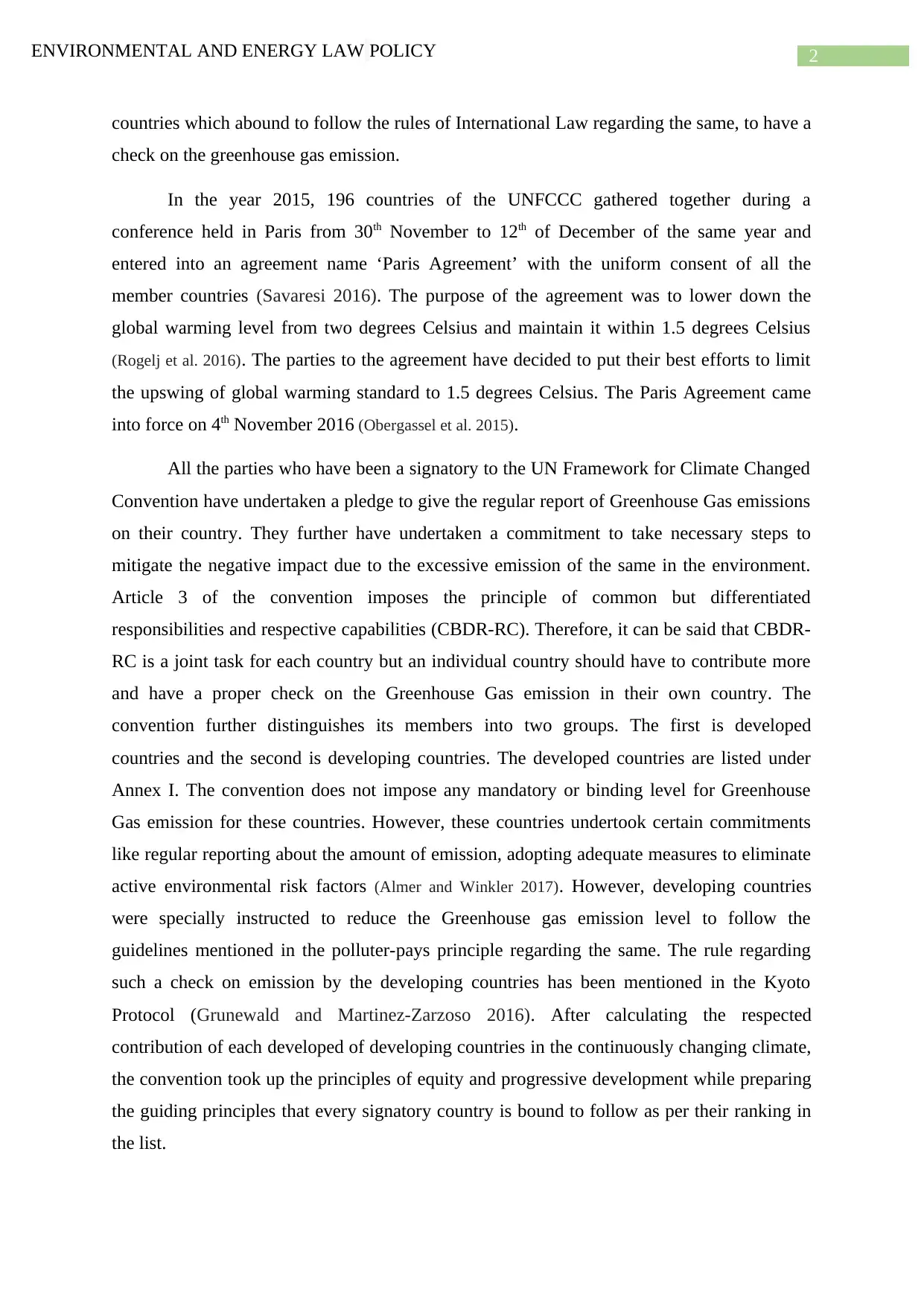
2ENVIRONMENTAL AND ENERGY LAW POLICY
countries which abound to follow the rules of International Law regarding the same, to have a
check on the greenhouse gas emission.
In the year 2015, 196 countries of the UNFCCC gathered together during a
conference held in Paris from 30th November to 12th of December of the same year and
entered into an agreement name ‘Paris Agreement’ with the uniform consent of all the
member countries (Savaresi 2016). The purpose of the agreement was to lower down the
global warming level from two degrees Celsius and maintain it within 1.5 degrees Celsius
(Rogelj et al. 2016). The parties to the agreement have decided to put their best efforts to limit
the upswing of global warming standard to 1.5 degrees Celsius. The Paris Agreement came
into force on 4th November 2016 (Obergassel et al. 2015).
All the parties who have been a signatory to the UN Framework for Climate Changed
Convention have undertaken a pledge to give the regular report of Greenhouse Gas emissions
on their country. They further have undertaken a commitment to take necessary steps to
mitigate the negative impact due to the excessive emission of the same in the environment.
Article 3 of the convention imposes the principle of common but differentiated
responsibilities and respective capabilities (CBDR-RC). Therefore, it can be said that CBDR-
RC is a joint task for each country but an individual country should have to contribute more
and have a proper check on the Greenhouse Gas emission in their own country. The
convention further distinguishes its members into two groups. The first is developed
countries and the second is developing countries. The developed countries are listed under
Annex I. The convention does not impose any mandatory or binding level for Greenhouse
Gas emission for these countries. However, these countries undertook certain commitments
like regular reporting about the amount of emission, adopting adequate measures to eliminate
active environmental risk factors (Almer and Winkler 2017). However, developing countries
were specially instructed to reduce the Greenhouse gas emission level to follow the
guidelines mentioned in the polluter-pays principle regarding the same. The rule regarding
such a check on emission by the developing countries has been mentioned in the Kyoto
Protocol (Grunewald and Martinez-Zarzoso 2016). After calculating the respected
contribution of each developed of developing countries in the continuously changing climate,
the convention took up the principles of equity and progressive development while preparing
the guiding principles that every signatory country is bound to follow as per their ranking in
the list.
countries which abound to follow the rules of International Law regarding the same, to have a
check on the greenhouse gas emission.
In the year 2015, 196 countries of the UNFCCC gathered together during a
conference held in Paris from 30th November to 12th of December of the same year and
entered into an agreement name ‘Paris Agreement’ with the uniform consent of all the
member countries (Savaresi 2016). The purpose of the agreement was to lower down the
global warming level from two degrees Celsius and maintain it within 1.5 degrees Celsius
(Rogelj et al. 2016). The parties to the agreement have decided to put their best efforts to limit
the upswing of global warming standard to 1.5 degrees Celsius. The Paris Agreement came
into force on 4th November 2016 (Obergassel et al. 2015).
All the parties who have been a signatory to the UN Framework for Climate Changed
Convention have undertaken a pledge to give the regular report of Greenhouse Gas emissions
on their country. They further have undertaken a commitment to take necessary steps to
mitigate the negative impact due to the excessive emission of the same in the environment.
Article 3 of the convention imposes the principle of common but differentiated
responsibilities and respective capabilities (CBDR-RC). Therefore, it can be said that CBDR-
RC is a joint task for each country but an individual country should have to contribute more
and have a proper check on the Greenhouse Gas emission in their own country. The
convention further distinguishes its members into two groups. The first is developed
countries and the second is developing countries. The developed countries are listed under
Annex I. The convention does not impose any mandatory or binding level for Greenhouse
Gas emission for these countries. However, these countries undertook certain commitments
like regular reporting about the amount of emission, adopting adequate measures to eliminate
active environmental risk factors (Almer and Winkler 2017). However, developing countries
were specially instructed to reduce the Greenhouse gas emission level to follow the
guidelines mentioned in the polluter-pays principle regarding the same. The rule regarding
such a check on emission by the developing countries has been mentioned in the Kyoto
Protocol (Grunewald and Martinez-Zarzoso 2016). After calculating the respected
contribution of each developed of developing countries in the continuously changing climate,
the convention took up the principles of equity and progressive development while preparing
the guiding principles that every signatory country is bound to follow as per their ranking in
the list.
⊘ This is a preview!⊘
Do you want full access?
Subscribe today to unlock all pages.

Trusted by 1+ million students worldwide
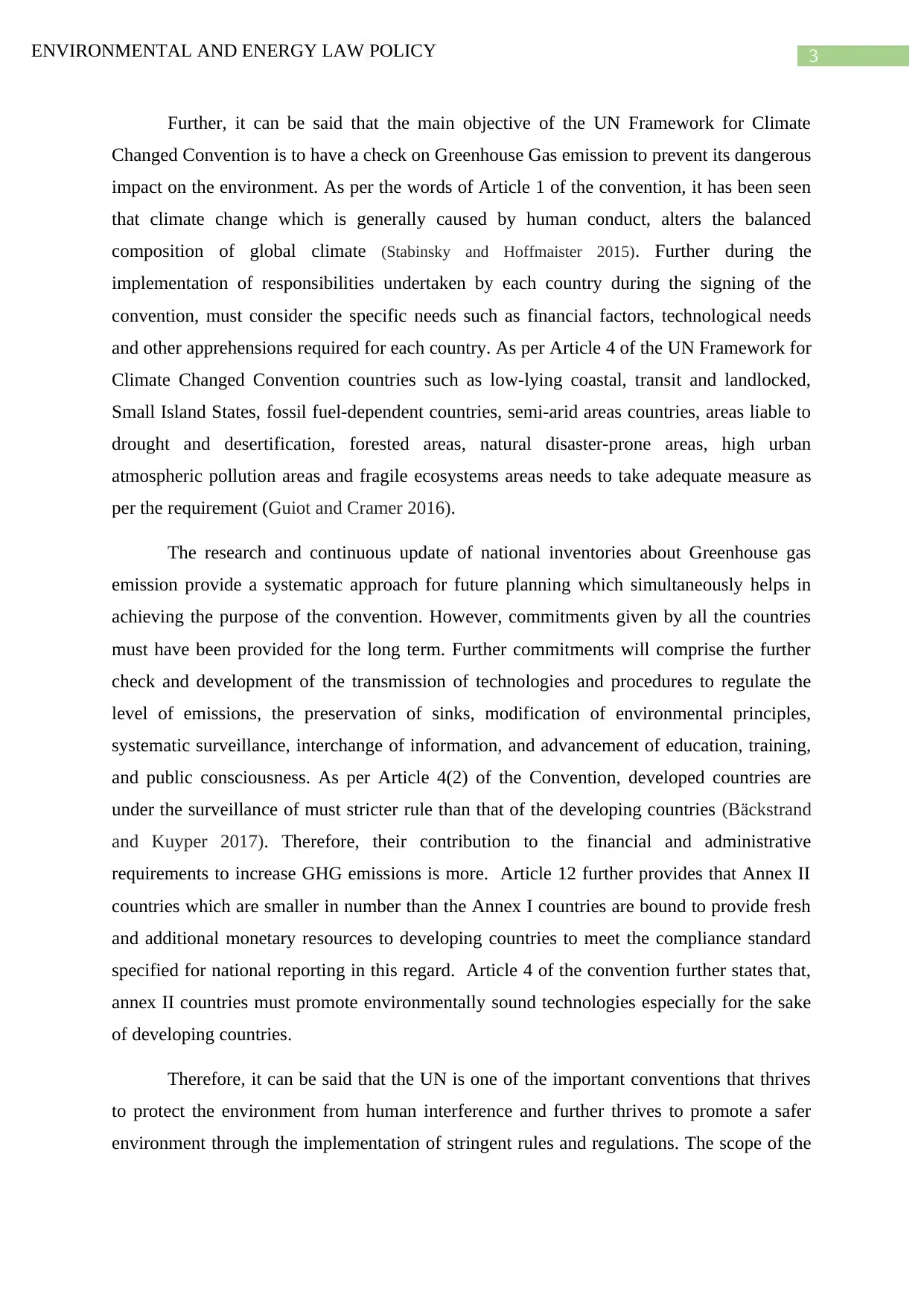
3ENVIRONMENTAL AND ENERGY LAW POLICY
Further, it can be said that the main objective of the UN Framework for Climate
Changed Convention is to have a check on Greenhouse Gas emission to prevent its dangerous
impact on the environment. As per the words of Article 1 of the convention, it has been seen
that climate change which is generally caused by human conduct, alters the balanced
composition of global climate (Stabinsky and Hoffmaister 2015). Further during the
implementation of responsibilities undertaken by each country during the signing of the
convention, must consider the specific needs such as financial factors, technological needs
and other apprehensions required for each country. As per Article 4 of the UN Framework for
Climate Changed Convention countries such as low-lying coastal, transit and landlocked,
Small Island States, fossil fuel-dependent countries, semi-arid areas countries, areas liable to
drought and desertification, forested areas, natural disaster-prone areas, high urban
atmospheric pollution areas and fragile ecosystems areas needs to take adequate measure as
per the requirement (Guiot and Cramer 2016).
The research and continuous update of national inventories about Greenhouse gas
emission provide a systematic approach for future planning which simultaneously helps in
achieving the purpose of the convention. However, commitments given by all the countries
must have been provided for the long term. Further commitments will comprise the further
check and development of the transmission of technologies and procedures to regulate the
level of emissions, the preservation of sinks, modification of environmental principles,
systematic surveillance, interchange of information, and advancement of education, training,
and public consciousness. As per Article 4(2) of the Convention, developed countries are
under the surveillance of must stricter rule than that of the developing countries (Bäckstrand
and Kuyper 2017). Therefore, their contribution to the financial and administrative
requirements to increase GHG emissions is more. Article 12 further provides that Annex II
countries which are smaller in number than the Annex I countries are bound to provide fresh
and additional monetary resources to developing countries to meet the compliance standard
specified for national reporting in this regard. Article 4 of the convention further states that,
annex II countries must promote environmentally sound technologies especially for the sake
of developing countries.
Therefore, it can be said that the UN is one of the important conventions that thrives
to protect the environment from human interference and further thrives to promote a safer
environment through the implementation of stringent rules and regulations. The scope of the
Further, it can be said that the main objective of the UN Framework for Climate
Changed Convention is to have a check on Greenhouse Gas emission to prevent its dangerous
impact on the environment. As per the words of Article 1 of the convention, it has been seen
that climate change which is generally caused by human conduct, alters the balanced
composition of global climate (Stabinsky and Hoffmaister 2015). Further during the
implementation of responsibilities undertaken by each country during the signing of the
convention, must consider the specific needs such as financial factors, technological needs
and other apprehensions required for each country. As per Article 4 of the UN Framework for
Climate Changed Convention countries such as low-lying coastal, transit and landlocked,
Small Island States, fossil fuel-dependent countries, semi-arid areas countries, areas liable to
drought and desertification, forested areas, natural disaster-prone areas, high urban
atmospheric pollution areas and fragile ecosystems areas needs to take adequate measure as
per the requirement (Guiot and Cramer 2016).
The research and continuous update of national inventories about Greenhouse gas
emission provide a systematic approach for future planning which simultaneously helps in
achieving the purpose of the convention. However, commitments given by all the countries
must have been provided for the long term. Further commitments will comprise the further
check and development of the transmission of technologies and procedures to regulate the
level of emissions, the preservation of sinks, modification of environmental principles,
systematic surveillance, interchange of information, and advancement of education, training,
and public consciousness. As per Article 4(2) of the Convention, developed countries are
under the surveillance of must stricter rule than that of the developing countries (Bäckstrand
and Kuyper 2017). Therefore, their contribution to the financial and administrative
requirements to increase GHG emissions is more. Article 12 further provides that Annex II
countries which are smaller in number than the Annex I countries are bound to provide fresh
and additional monetary resources to developing countries to meet the compliance standard
specified for national reporting in this regard. Article 4 of the convention further states that,
annex II countries must promote environmentally sound technologies especially for the sake
of developing countries.
Therefore, it can be said that the UN is one of the important conventions that thrives
to protect the environment from human interference and further thrives to promote a safer
environment through the implementation of stringent rules and regulations. The scope of the
Paraphrase This Document
Need a fresh take? Get an instant paraphrase of this document with our AI Paraphraser
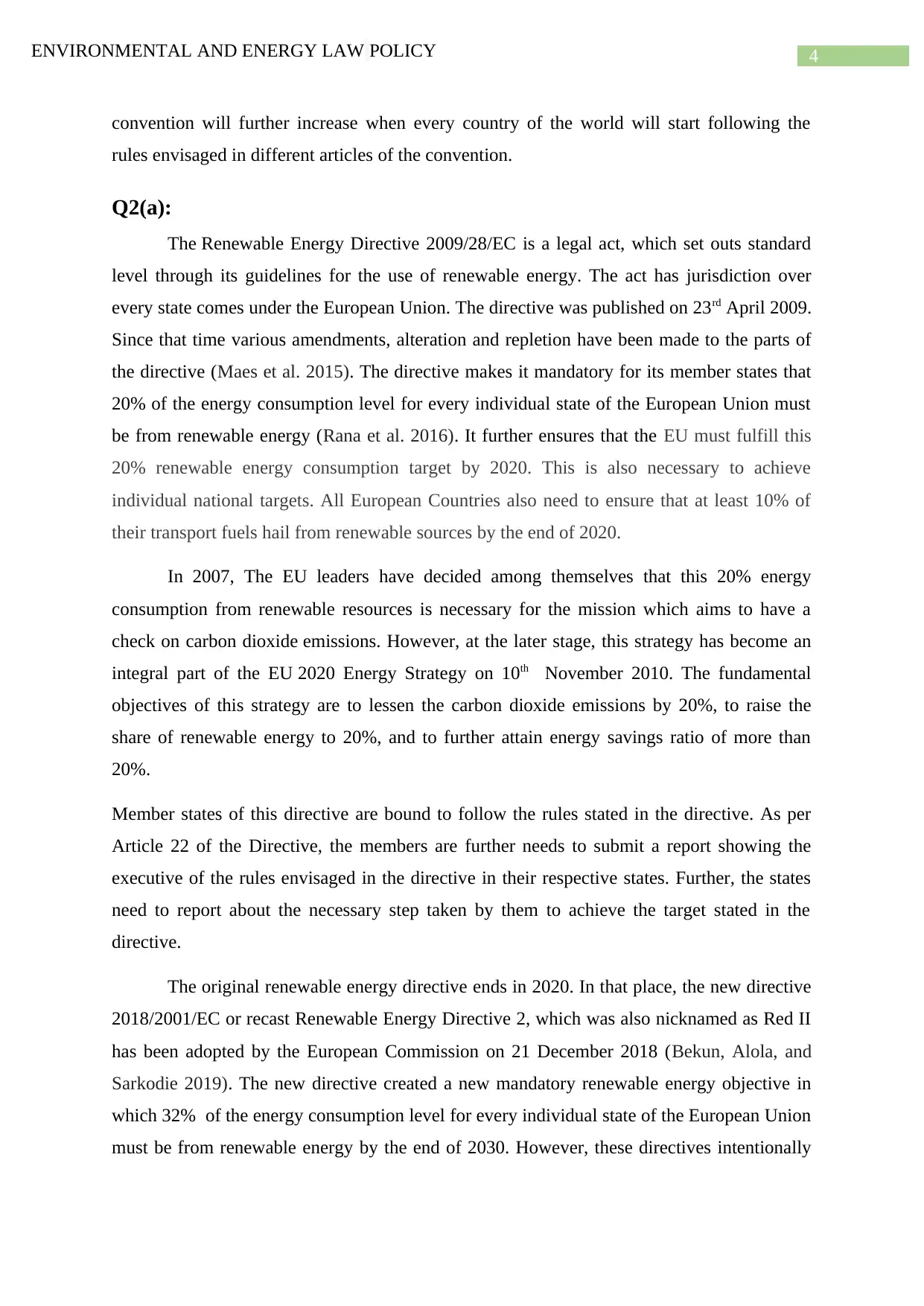
4ENVIRONMENTAL AND ENERGY LAW POLICY
convention will further increase when every country of the world will start following the
rules envisaged in different articles of the convention.
Q2(a):
The Renewable Energy Directive 2009/28/EC is a legal act, which set outs standard
level through its guidelines for the use of renewable energy. The act has jurisdiction over
every state comes under the European Union. The directive was published on 23rd April 2009.
Since that time various amendments, alteration and repletion have been made to the parts of
the directive (Maes et al. 2015). The directive makes it mandatory for its member states that
20% of the energy consumption level for every individual state of the European Union must
be from renewable energy (Rana et al. 2016). It further ensures that the EU must fulfill this
20% renewable energy consumption target by 2020. This is also necessary to achieve
individual national targets. All European Countries also need to ensure that at least 10% of
their transport fuels hail from renewable sources by the end of 2020.
In 2007, The EU leaders have decided among themselves that this 20% energy
consumption from renewable resources is necessary for the mission which aims to have a
check on carbon dioxide emissions. However, at the later stage, this strategy has become an
integral part of the EU 2020 Energy Strategy on 10th November 2010. The fundamental
objectives of this strategy are to lessen the carbon dioxide emissions by 20%, to raise the
share of renewable energy to 20%, and to further attain energy savings ratio of more than
20%.
Member states of this directive are bound to follow the rules stated in the directive. As per
Article 22 of the Directive, the members are further needs to submit a report showing the
executive of the rules envisaged in the directive in their respective states. Further, the states
need to report about the necessary step taken by them to achieve the target stated in the
directive.
The original renewable energy directive ends in 2020. In that place, the new directive
2018/2001/EC or recast Renewable Energy Directive 2, which was also nicknamed as Red II
has been adopted by the European Commission on 21 December 2018 (Bekun, Alola, and
Sarkodie 2019). The new directive created a new mandatory renewable energy objective in
which 32% of the energy consumption level for every individual state of the European Union
must be from renewable energy by the end of 2030. However, these directives intentionally
convention will further increase when every country of the world will start following the
rules envisaged in different articles of the convention.
Q2(a):
The Renewable Energy Directive 2009/28/EC is a legal act, which set outs standard
level through its guidelines for the use of renewable energy. The act has jurisdiction over
every state comes under the European Union. The directive was published on 23rd April 2009.
Since that time various amendments, alteration and repletion have been made to the parts of
the directive (Maes et al. 2015). The directive makes it mandatory for its member states that
20% of the energy consumption level for every individual state of the European Union must
be from renewable energy (Rana et al. 2016). It further ensures that the EU must fulfill this
20% renewable energy consumption target by 2020. This is also necessary to achieve
individual national targets. All European Countries also need to ensure that at least 10% of
their transport fuels hail from renewable sources by the end of 2020.
In 2007, The EU leaders have decided among themselves that this 20% energy
consumption from renewable resources is necessary for the mission which aims to have a
check on carbon dioxide emissions. However, at the later stage, this strategy has become an
integral part of the EU 2020 Energy Strategy on 10th November 2010. The fundamental
objectives of this strategy are to lessen the carbon dioxide emissions by 20%, to raise the
share of renewable energy to 20%, and to further attain energy savings ratio of more than
20%.
Member states of this directive are bound to follow the rules stated in the directive. As per
Article 22 of the Directive, the members are further needs to submit a report showing the
executive of the rules envisaged in the directive in their respective states. Further, the states
need to report about the necessary step taken by them to achieve the target stated in the
directive.
The original renewable energy directive ends in 2020. In that place, the new directive
2018/2001/EC or recast Renewable Energy Directive 2, which was also nicknamed as Red II
has been adopted by the European Commission on 21 December 2018 (Bekun, Alola, and
Sarkodie 2019). The new directive created a new mandatory renewable energy objective in
which 32% of the energy consumption level for every individual state of the European Union
must be from renewable energy by the end of 2030. However, these directives intentionally
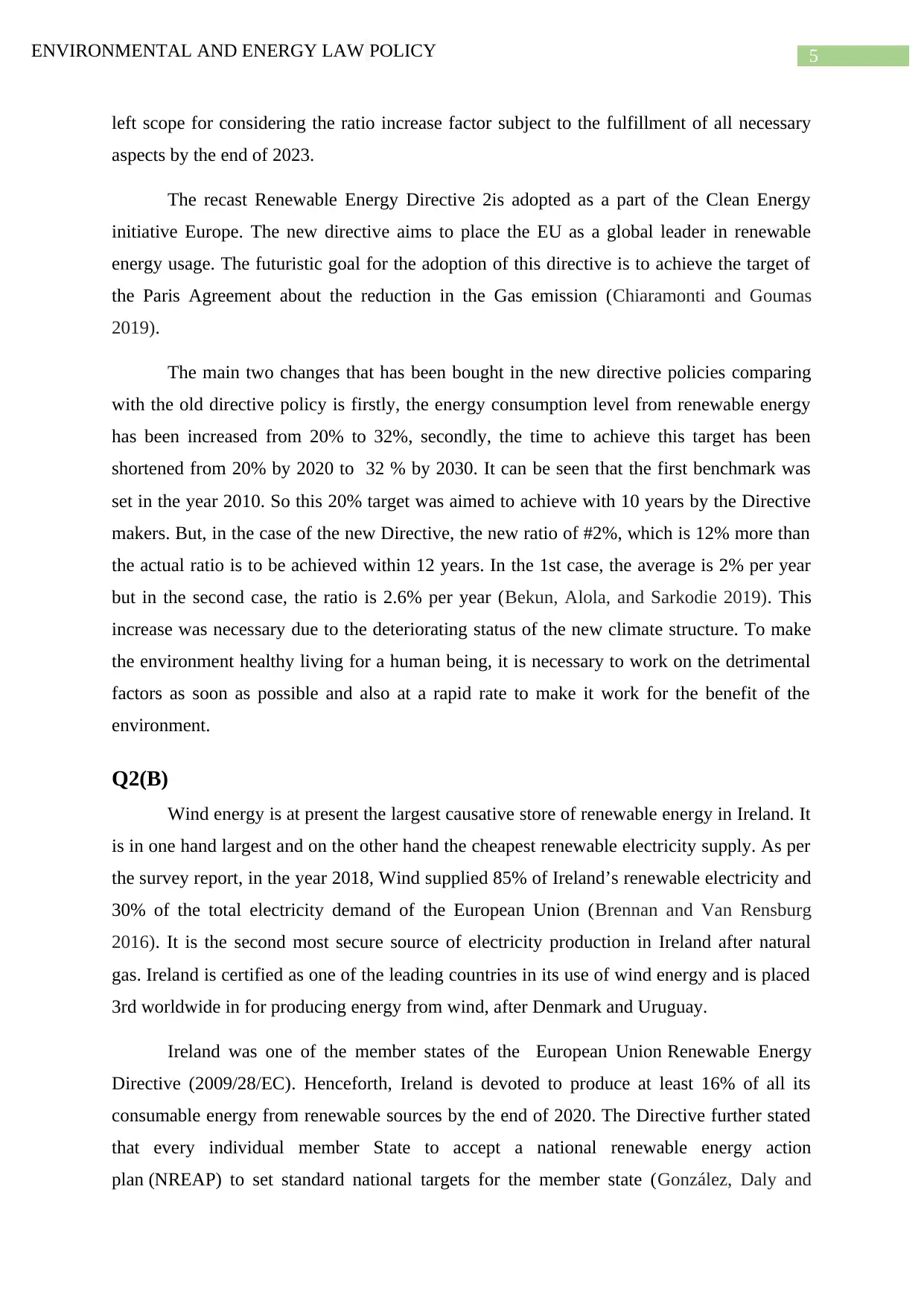
5ENVIRONMENTAL AND ENERGY LAW POLICY
left scope for considering the ratio increase factor subject to the fulfillment of all necessary
aspects by the end of 2023.
The recast Renewable Energy Directive 2is adopted as a part of the Clean Energy
initiative Europe. The new directive aims to place the EU as a global leader in renewable
energy usage. The futuristic goal for the adoption of this directive is to achieve the target of
the Paris Agreement about the reduction in the Gas emission (Chiaramonti and Goumas
2019).
The main two changes that has been bought in the new directive policies comparing
with the old directive policy is firstly, the energy consumption level from renewable energy
has been increased from 20% to 32%, secondly, the time to achieve this target has been
shortened from 20% by 2020 to 32 % by 2030. It can be seen that the first benchmark was
set in the year 2010. So this 20% target was aimed to achieve with 10 years by the Directive
makers. But, in the case of the new Directive, the new ratio of #2%, which is 12% more than
the actual ratio is to be achieved within 12 years. In the 1st case, the average is 2% per year
but in the second case, the ratio is 2.6% per year (Bekun, Alola, and Sarkodie 2019). This
increase was necessary due to the deteriorating status of the new climate structure. To make
the environment healthy living for a human being, it is necessary to work on the detrimental
factors as soon as possible and also at a rapid rate to make it work for the benefit of the
environment.
Q2(B)
Wind energy is at present the largest causative store of renewable energy in Ireland. It
is in one hand largest and on the other hand the cheapest renewable electricity supply. As per
the survey report, in the year 2018, Wind supplied 85% of Ireland’s renewable electricity and
30% of the total electricity demand of the European Union (Brennan and Van Rensburg
2016). It is the second most secure source of electricity production in Ireland after natural
gas. Ireland is certified as one of the leading countries in its use of wind energy and is placed
3rd worldwide in for producing energy from wind, after Denmark and Uruguay.
Ireland was one of the member states of the European Union Renewable Energy
Directive (2009/28/EC). Henceforth, Ireland is devoted to produce at least 16% of all its
consumable energy from renewable sources by the end of 2020. The Directive further stated
that every individual member State to accept a national renewable energy action
plan (NREAP) to set standard national targets for the member state (González, Daly and
left scope for considering the ratio increase factor subject to the fulfillment of all necessary
aspects by the end of 2023.
The recast Renewable Energy Directive 2is adopted as a part of the Clean Energy
initiative Europe. The new directive aims to place the EU as a global leader in renewable
energy usage. The futuristic goal for the adoption of this directive is to achieve the target of
the Paris Agreement about the reduction in the Gas emission (Chiaramonti and Goumas
2019).
The main two changes that has been bought in the new directive policies comparing
with the old directive policy is firstly, the energy consumption level from renewable energy
has been increased from 20% to 32%, secondly, the time to achieve this target has been
shortened from 20% by 2020 to 32 % by 2030. It can be seen that the first benchmark was
set in the year 2010. So this 20% target was aimed to achieve with 10 years by the Directive
makers. But, in the case of the new Directive, the new ratio of #2%, which is 12% more than
the actual ratio is to be achieved within 12 years. In the 1st case, the average is 2% per year
but in the second case, the ratio is 2.6% per year (Bekun, Alola, and Sarkodie 2019). This
increase was necessary due to the deteriorating status of the new climate structure. To make
the environment healthy living for a human being, it is necessary to work on the detrimental
factors as soon as possible and also at a rapid rate to make it work for the benefit of the
environment.
Q2(B)
Wind energy is at present the largest causative store of renewable energy in Ireland. It
is in one hand largest and on the other hand the cheapest renewable electricity supply. As per
the survey report, in the year 2018, Wind supplied 85% of Ireland’s renewable electricity and
30% of the total electricity demand of the European Union (Brennan and Van Rensburg
2016). It is the second most secure source of electricity production in Ireland after natural
gas. Ireland is certified as one of the leading countries in its use of wind energy and is placed
3rd worldwide in for producing energy from wind, after Denmark and Uruguay.
Ireland was one of the member states of the European Union Renewable Energy
Directive (2009/28/EC). Henceforth, Ireland is devoted to produce at least 16% of all its
consumable energy from renewable sources by the end of 2020. The Directive further stated
that every individual member State to accept a national renewable energy action
plan (NREAP) to set standard national targets for the member state (González, Daly and
⊘ This is a preview!⊘
Do you want full access?
Subscribe today to unlock all pages.

Trusted by 1+ million students worldwide
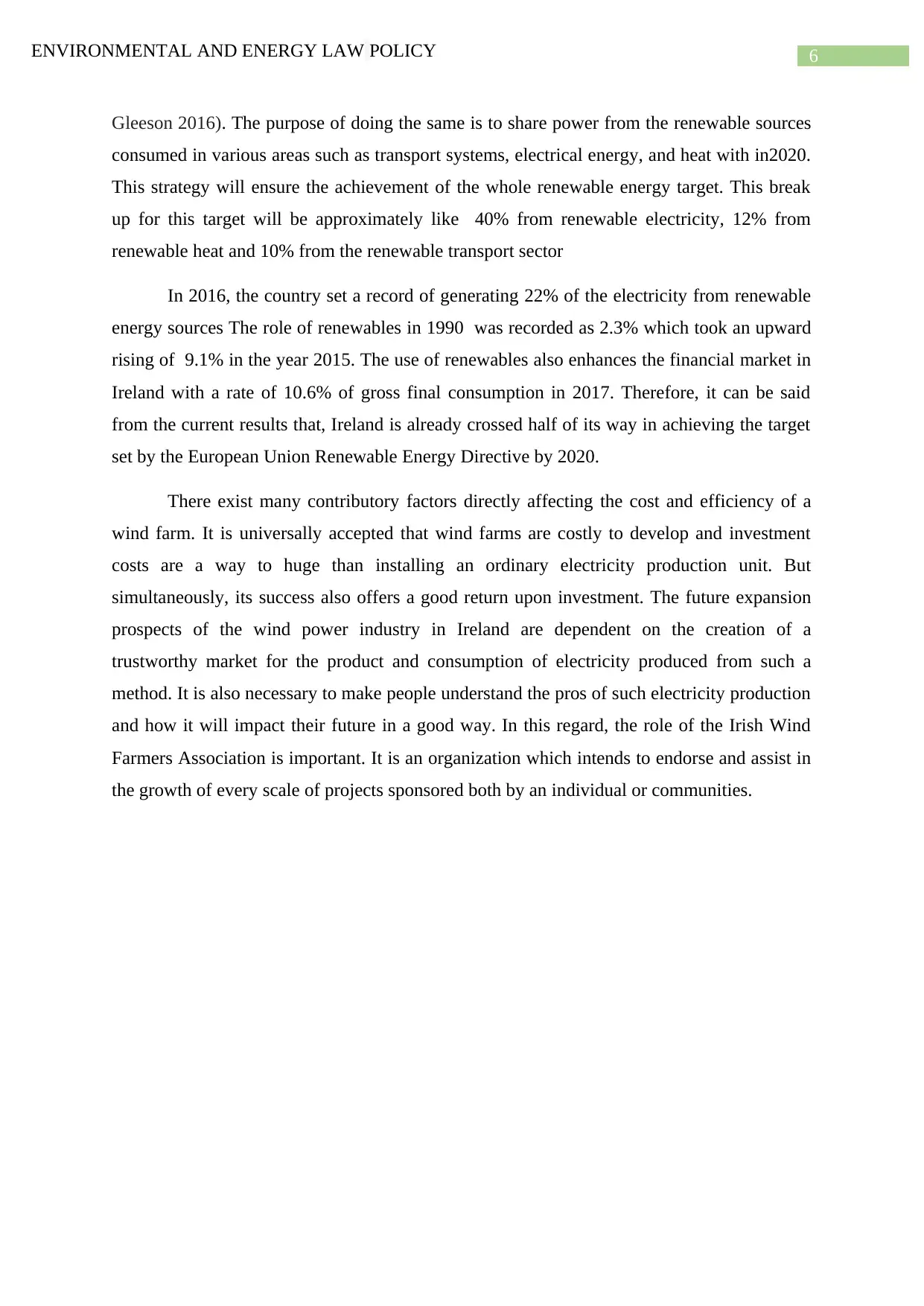
6ENVIRONMENTAL AND ENERGY LAW POLICY
Gleeson 2016). The purpose of doing the same is to share power from the renewable sources
consumed in various areas such as transport systems, electrical energy, and heat with in2020.
This strategy will ensure the achievement of the whole renewable energy target. This break
up for this target will be approximately like 40% from renewable electricity, 12% from
renewable heat and 10% from the renewable transport sector
In 2016, the country set a record of generating 22% of the electricity from renewable
energy sources The role of renewables in 1990 was recorded as 2.3% which took an upward
rising of 9.1% in the year 2015. The use of renewables also enhances the financial market in
Ireland with a rate of 10.6% of gross final consumption in 2017. Therefore, it can be said
from the current results that, Ireland is already crossed half of its way in achieving the target
set by the European Union Renewable Energy Directive by 2020.
There exist many contributory factors directly affecting the cost and efficiency of a
wind farm. It is universally accepted that wind farms are costly to develop and investment
costs are a way to huge than installing an ordinary electricity production unit. But
simultaneously, its success also offers a good return upon investment. The future expansion
prospects of the wind power industry in Ireland are dependent on the creation of a
trustworthy market for the product and consumption of electricity produced from such a
method. It is also necessary to make people understand the pros of such electricity production
and how it will impact their future in a good way. In this regard, the role of the Irish Wind
Farmers Association is important. It is an organization which intends to endorse and assist in
the growth of every scale of projects sponsored both by an individual or communities.
Gleeson 2016). The purpose of doing the same is to share power from the renewable sources
consumed in various areas such as transport systems, electrical energy, and heat with in2020.
This strategy will ensure the achievement of the whole renewable energy target. This break
up for this target will be approximately like 40% from renewable electricity, 12% from
renewable heat and 10% from the renewable transport sector
In 2016, the country set a record of generating 22% of the electricity from renewable
energy sources The role of renewables in 1990 was recorded as 2.3% which took an upward
rising of 9.1% in the year 2015. The use of renewables also enhances the financial market in
Ireland with a rate of 10.6% of gross final consumption in 2017. Therefore, it can be said
from the current results that, Ireland is already crossed half of its way in achieving the target
set by the European Union Renewable Energy Directive by 2020.
There exist many contributory factors directly affecting the cost and efficiency of a
wind farm. It is universally accepted that wind farms are costly to develop and investment
costs are a way to huge than installing an ordinary electricity production unit. But
simultaneously, its success also offers a good return upon investment. The future expansion
prospects of the wind power industry in Ireland are dependent on the creation of a
trustworthy market for the product and consumption of electricity produced from such a
method. It is also necessary to make people understand the pros of such electricity production
and how it will impact their future in a good way. In this regard, the role of the Irish Wind
Farmers Association is important. It is an organization which intends to endorse and assist in
the growth of every scale of projects sponsored both by an individual or communities.
Paraphrase This Document
Need a fresh take? Get an instant paraphrase of this document with our AI Paraphraser
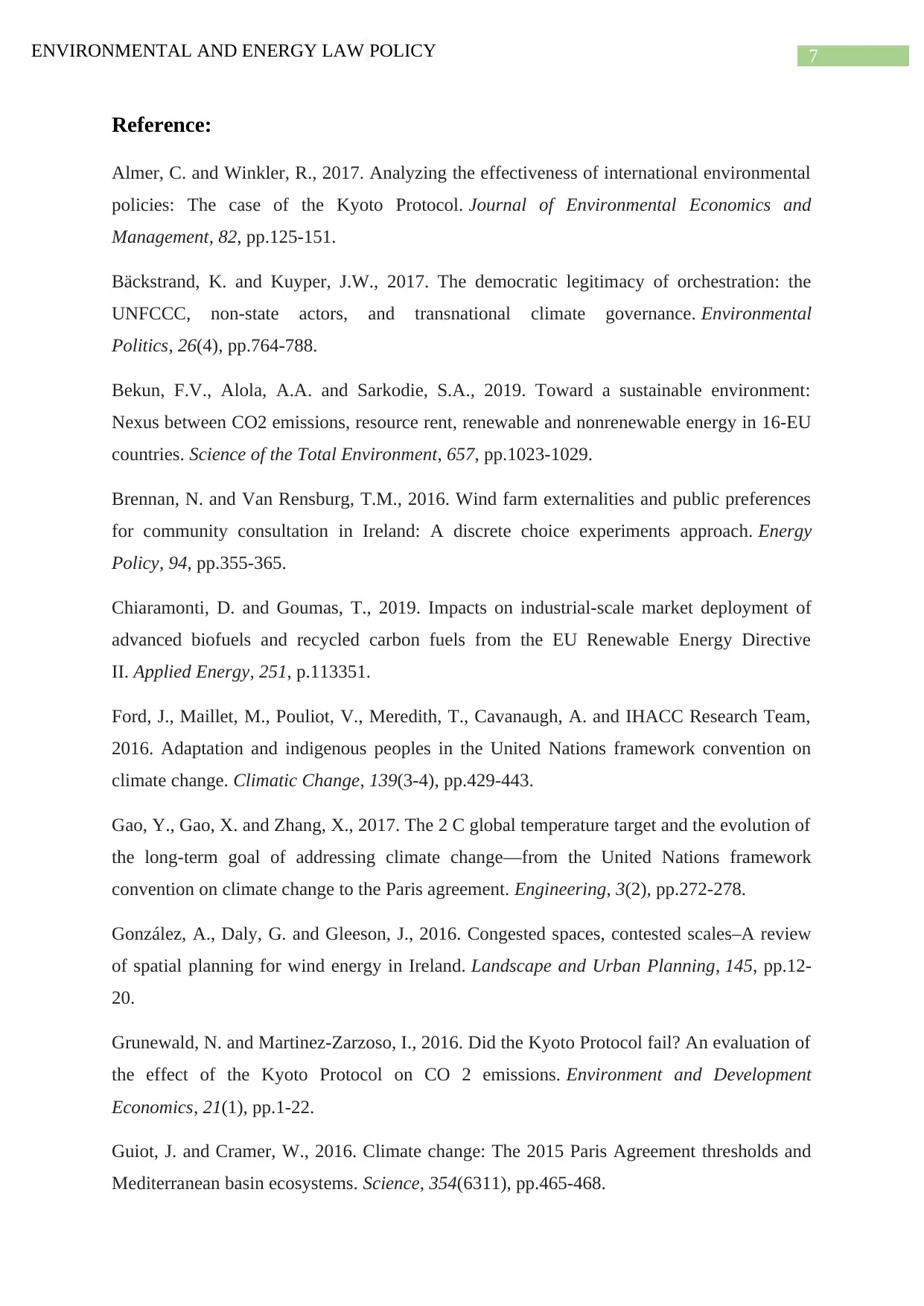
7ENVIRONMENTAL AND ENERGY LAW POLICY
Reference:
Almer, C. and Winkler, R., 2017. Analyzing the effectiveness of international environmental
policies: The case of the Kyoto Protocol. Journal of Environmental Economics and
Management, 82, pp.125-151.
Bäckstrand, K. and Kuyper, J.W., 2017. The democratic legitimacy of orchestration: the
UNFCCC, non-state actors, and transnational climate governance. Environmental
Politics, 26(4), pp.764-788.
Bekun, F.V., Alola, A.A. and Sarkodie, S.A., 2019. Toward a sustainable environment:
Nexus between CO2 emissions, resource rent, renewable and nonrenewable energy in 16-EU
countries. Science of the Total Environment, 657, pp.1023-1029.
Brennan, N. and Van Rensburg, T.M., 2016. Wind farm externalities and public preferences
for community consultation in Ireland: A discrete choice experiments approach. Energy
Policy, 94, pp.355-365.
Chiaramonti, D. and Goumas, T., 2019. Impacts on industrial-scale market deployment of
advanced biofuels and recycled carbon fuels from the EU Renewable Energy Directive
II. Applied Energy, 251, p.113351.
Ford, J., Maillet, M., Pouliot, V., Meredith, T., Cavanaugh, A. and IHACC Research Team,
2016. Adaptation and indigenous peoples in the United Nations framework convention on
climate change. Climatic Change, 139(3-4), pp.429-443.
Gao, Y., Gao, X. and Zhang, X., 2017. The 2 C global temperature target and the evolution of
the long-term goal of addressing climate change—from the United Nations framework
convention on climate change to the Paris agreement. Engineering, 3(2), pp.272-278.
González, A., Daly, G. and Gleeson, J., 2016. Congested spaces, contested scales–A review
of spatial planning for wind energy in Ireland. Landscape and Urban Planning, 145, pp.12-
20.
Grunewald, N. and Martinez-Zarzoso, I., 2016. Did the Kyoto Protocol fail? An evaluation of
the effect of the Kyoto Protocol on CO 2 emissions. Environment and Development
Economics, 21(1), pp.1-22.
Guiot, J. and Cramer, W., 2016. Climate change: The 2015 Paris Agreement thresholds and
Mediterranean basin ecosystems. Science, 354(6311), pp.465-468.
Reference:
Almer, C. and Winkler, R., 2017. Analyzing the effectiveness of international environmental
policies: The case of the Kyoto Protocol. Journal of Environmental Economics and
Management, 82, pp.125-151.
Bäckstrand, K. and Kuyper, J.W., 2017. The democratic legitimacy of orchestration: the
UNFCCC, non-state actors, and transnational climate governance. Environmental
Politics, 26(4), pp.764-788.
Bekun, F.V., Alola, A.A. and Sarkodie, S.A., 2019. Toward a sustainable environment:
Nexus between CO2 emissions, resource rent, renewable and nonrenewable energy in 16-EU
countries. Science of the Total Environment, 657, pp.1023-1029.
Brennan, N. and Van Rensburg, T.M., 2016. Wind farm externalities and public preferences
for community consultation in Ireland: A discrete choice experiments approach. Energy
Policy, 94, pp.355-365.
Chiaramonti, D. and Goumas, T., 2019. Impacts on industrial-scale market deployment of
advanced biofuels and recycled carbon fuels from the EU Renewable Energy Directive
II. Applied Energy, 251, p.113351.
Ford, J., Maillet, M., Pouliot, V., Meredith, T., Cavanaugh, A. and IHACC Research Team,
2016. Adaptation and indigenous peoples in the United Nations framework convention on
climate change. Climatic Change, 139(3-4), pp.429-443.
Gao, Y., Gao, X. and Zhang, X., 2017. The 2 C global temperature target and the evolution of
the long-term goal of addressing climate change—from the United Nations framework
convention on climate change to the Paris agreement. Engineering, 3(2), pp.272-278.
González, A., Daly, G. and Gleeson, J., 2016. Congested spaces, contested scales–A review
of spatial planning for wind energy in Ireland. Landscape and Urban Planning, 145, pp.12-
20.
Grunewald, N. and Martinez-Zarzoso, I., 2016. Did the Kyoto Protocol fail? An evaluation of
the effect of the Kyoto Protocol on CO 2 emissions. Environment and Development
Economics, 21(1), pp.1-22.
Guiot, J. and Cramer, W., 2016. Climate change: The 2015 Paris Agreement thresholds and
Mediterranean basin ecosystems. Science, 354(6311), pp.465-468.
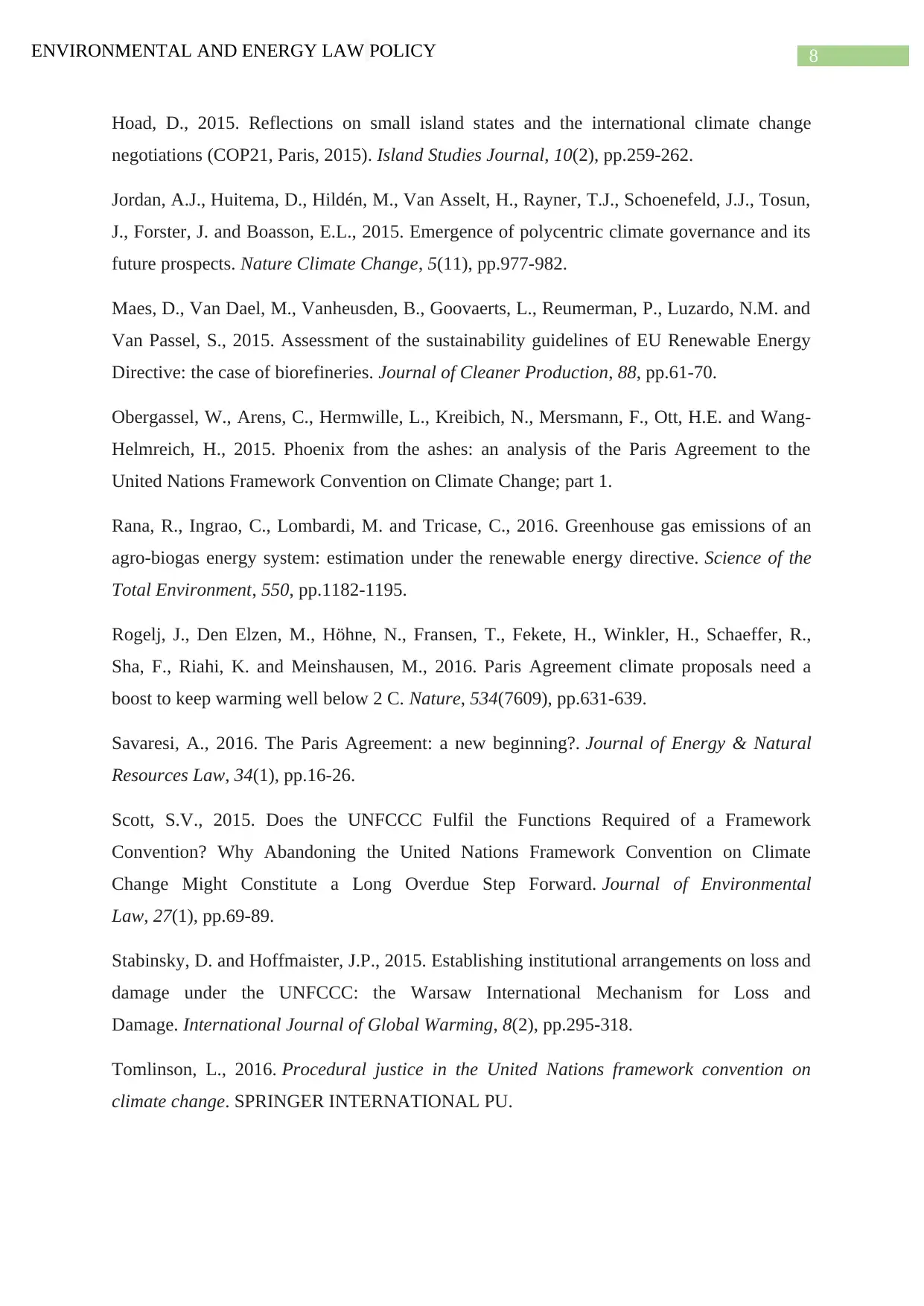
8ENVIRONMENTAL AND ENERGY LAW POLICY
Hoad, D., 2015. Reflections on small island states and the international climate change
negotiations (COP21, Paris, 2015). Island Studies Journal, 10(2), pp.259-262.
Jordan, A.J., Huitema, D., Hildén, M., Van Asselt, H., Rayner, T.J., Schoenefeld, J.J., Tosun,
J., Forster, J. and Boasson, E.L., 2015. Emergence of polycentric climate governance and its
future prospects. Nature Climate Change, 5(11), pp.977-982.
Maes, D., Van Dael, M., Vanheusden, B., Goovaerts, L., Reumerman, P., Luzardo, N.M. and
Van Passel, S., 2015. Assessment of the sustainability guidelines of EU Renewable Energy
Directive: the case of biorefineries. Journal of Cleaner Production, 88, pp.61-70.
Obergassel, W., Arens, C., Hermwille, L., Kreibich, N., Mersmann, F., Ott, H.E. and Wang-
Helmreich, H., 2015. Phoenix from the ashes: an analysis of the Paris Agreement to the
United Nations Framework Convention on Climate Change; part 1.
Rana, R., Ingrao, C., Lombardi, M. and Tricase, C., 2016. Greenhouse gas emissions of an
agro-biogas energy system: estimation under the renewable energy directive. Science of the
Total Environment, 550, pp.1182-1195.
Rogelj, J., Den Elzen, M., Höhne, N., Fransen, T., Fekete, H., Winkler, H., Schaeffer, R.,
Sha, F., Riahi, K. and Meinshausen, M., 2016. Paris Agreement climate proposals need a
boost to keep warming well below 2 C. Nature, 534(7609), pp.631-639.
Savaresi, A., 2016. The Paris Agreement: a new beginning?. Journal of Energy & Natural
Resources Law, 34(1), pp.16-26.
Scott, S.V., 2015. Does the UNFCCC Fulfil the Functions Required of a Framework
Convention? Why Abandoning the United Nations Framework Convention on Climate
Change Might Constitute a Long Overdue Step Forward. Journal of Environmental
Law, 27(1), pp.69-89.
Stabinsky, D. and Hoffmaister, J.P., 2015. Establishing institutional arrangements on loss and
damage under the UNFCCC: the Warsaw International Mechanism for Loss and
Damage. International Journal of Global Warming, 8(2), pp.295-318.
Tomlinson, L., 2016. Procedural justice in the United Nations framework convention on
climate change. SPRINGER INTERNATIONAL PU.
Hoad, D., 2015. Reflections on small island states and the international climate change
negotiations (COP21, Paris, 2015). Island Studies Journal, 10(2), pp.259-262.
Jordan, A.J., Huitema, D., Hildén, M., Van Asselt, H., Rayner, T.J., Schoenefeld, J.J., Tosun,
J., Forster, J. and Boasson, E.L., 2015. Emergence of polycentric climate governance and its
future prospects. Nature Climate Change, 5(11), pp.977-982.
Maes, D., Van Dael, M., Vanheusden, B., Goovaerts, L., Reumerman, P., Luzardo, N.M. and
Van Passel, S., 2015. Assessment of the sustainability guidelines of EU Renewable Energy
Directive: the case of biorefineries. Journal of Cleaner Production, 88, pp.61-70.
Obergassel, W., Arens, C., Hermwille, L., Kreibich, N., Mersmann, F., Ott, H.E. and Wang-
Helmreich, H., 2015. Phoenix from the ashes: an analysis of the Paris Agreement to the
United Nations Framework Convention on Climate Change; part 1.
Rana, R., Ingrao, C., Lombardi, M. and Tricase, C., 2016. Greenhouse gas emissions of an
agro-biogas energy system: estimation under the renewable energy directive. Science of the
Total Environment, 550, pp.1182-1195.
Rogelj, J., Den Elzen, M., Höhne, N., Fransen, T., Fekete, H., Winkler, H., Schaeffer, R.,
Sha, F., Riahi, K. and Meinshausen, M., 2016. Paris Agreement climate proposals need a
boost to keep warming well below 2 C. Nature, 534(7609), pp.631-639.
Savaresi, A., 2016. The Paris Agreement: a new beginning?. Journal of Energy & Natural
Resources Law, 34(1), pp.16-26.
Scott, S.V., 2015. Does the UNFCCC Fulfil the Functions Required of a Framework
Convention? Why Abandoning the United Nations Framework Convention on Climate
Change Might Constitute a Long Overdue Step Forward. Journal of Environmental
Law, 27(1), pp.69-89.
Stabinsky, D. and Hoffmaister, J.P., 2015. Establishing institutional arrangements on loss and
damage under the UNFCCC: the Warsaw International Mechanism for Loss and
Damage. International Journal of Global Warming, 8(2), pp.295-318.
Tomlinson, L., 2016. Procedural justice in the United Nations framework convention on
climate change. SPRINGER INTERNATIONAL PU.
⊘ This is a preview!⊘
Do you want full access?
Subscribe today to unlock all pages.

Trusted by 1+ million students worldwide
1 out of 9
Related Documents
Your All-in-One AI-Powered Toolkit for Academic Success.
+13062052269
info@desklib.com
Available 24*7 on WhatsApp / Email
![[object Object]](/_next/static/media/star-bottom.7253800d.svg)
Unlock your academic potential
Copyright © 2020–2025 A2Z Services. All Rights Reserved. Developed and managed by ZUCOL.





